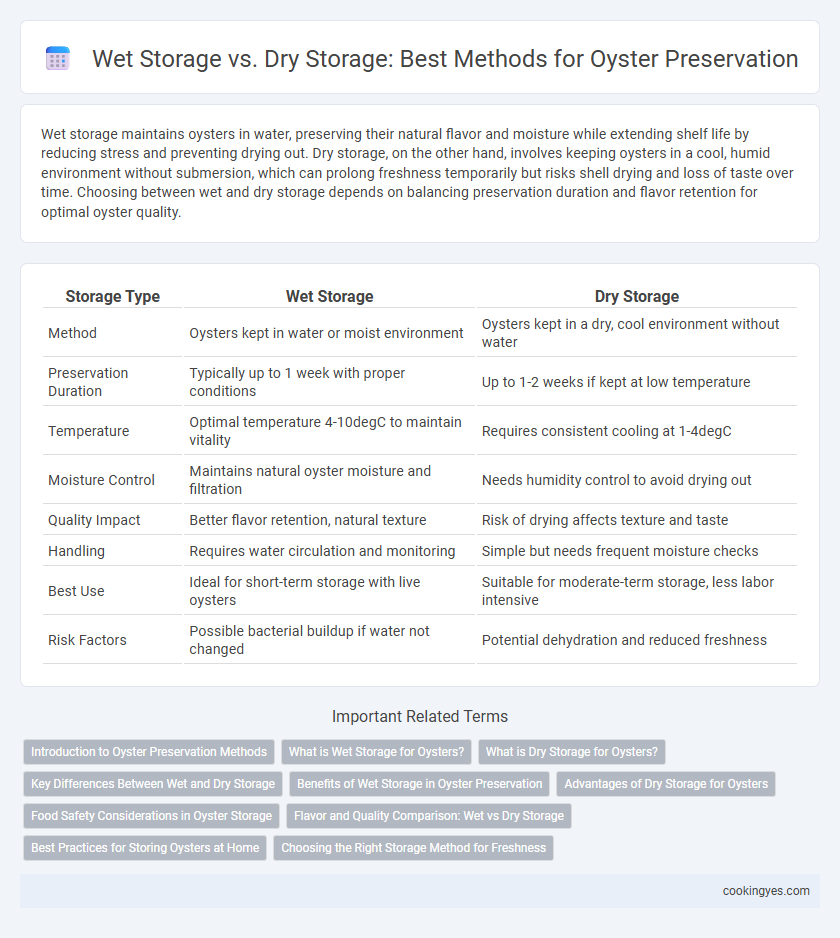Wet storage maintains oysters in water, preserving their natural flavor and moisture while extending shelf life by reducing stress and preventing drying out. Dry storage, on the other hand, involves keeping oysters in a cool, humid environment without submersion, which can prolong freshness temporarily but risks shell drying and loss of taste over time. Choosing between wet and dry storage depends on balancing preservation duration and flavor retention for optimal oyster quality.
Table of Comparison
| Storage Type | Wet Storage | Dry Storage |
|---|---|---|
| Method | Oysters kept in water or moist environment | Oysters kept in a dry, cool environment without water |
| Preservation Duration | Typically up to 1 week with proper conditions | Up to 1-2 weeks if kept at low temperature |
| Temperature | Optimal temperature 4-10degC to maintain vitality | Requires consistent cooling at 1-4degC |
| Moisture Control | Maintains natural oyster moisture and filtration | Needs humidity control to avoid drying out |
| Quality Impact | Better flavor retention, natural texture | Risk of drying affects texture and taste |
| Handling | Requires water circulation and monitoring | Simple but needs frequent moisture checks |
| Best Use | Ideal for short-term storage with live oysters | Suitable for moderate-term storage, less labor intensive |
| Risk Factors | Possible bacterial buildup if water not changed | Potential dehydration and reduced freshness |
Introduction to Oyster Preservation Methods
Wet storage keeps oysters alive by immersing them in a controlled aquatic environment that maintains optimal temperature, salinity, and oxygen levels, extending freshness up to two weeks. Dry storage involves keeping oysters in a cool, moist environment without water, using damp materials like seaweed or cloth, which slows metabolism and preserves quality for about a week. Both methods require careful temperature management, ideally between 4-10degC, to prevent spoilage and maintain oyster safety and flavor.
What is Wet Storage for Oysters?
Wet storage for oysters involves keeping them submerged in seawater or a controlled aquatic environment to maintain their freshness and natural moisture. This method helps preserve the oyster's flavor, texture, and overall quality by mimicking their natural habitat and reducing stress. Maintaining optimal salinity, temperature, and oxygen levels during wet storage is crucial to extending shelf life and preventing spoilage.
What is Dry Storage for Oysters?
Dry storage for oysters involves keeping the shellfish in a cool, well-ventilated environment without submerging them in water, which helps prevent spoilage by reducing bacterial growth. This method maintains the oysters' freshness by controlling humidity and temperature, typically between 35-45degF (1.5-7degC), ensuring they remain alive and safe for consumption. Dry storage is preferred for short-term preservation, as it minimizes the risk of contamination compared to wet storage, where oysters are kept in water.
Key Differences Between Wet and Dry Storage
Wet storage preserves oysters by submerging them in clean, aerated seawater, maintaining their humidity and natural environment, which prolongs freshness and flavor. Dry storage keeps oysters in a cool, moist environment without submersion, reducing exposure to contaminants but potentially shortening shelf life due to less constant hydration. Key differences include moisture retention levels, risk of contamination, and storage duration, with wet storage favoring longevity and dry storage emphasizing safety and ease of handling.
Benefits of Wet Storage in Oyster Preservation
Wet storage enhances oyster preservation by maintaining optimal moisture and saline conditions, which significantly prolongs freshness and shelf life. This method supports the oyster's natural metabolism, reducing stress and improving taste quality compared to dry storage. The controlled aquatic environment also minimizes bacterial growth, ensuring safer and higher-quality oysters for consumers.
Advantages of Dry Storage for Oysters
Dry storage for oysters offers superior preservation by minimizing microbial growth and reducing spoilage risk through controlled temperature and humidity levels. This method maintains oyster freshness longer by preventing waterlogged conditions that can degrade texture and flavor. Dry storage also facilitates easier handling and transportation while extending shelf life compared to traditional wet storage methods.
Food Safety Considerations in Oyster Storage
Wet storage maintains oysters in their natural aquatic environment, preserving freshness but requiring stringent water quality controls to prevent bacterial growth such as Vibrio vulnificus. Dry storage significantly reduces microbial risks by keeping oysters at low temperatures in high humidity, though prolonged dryness can impact oyster quality and shelf life. Proper temperature regulation, either in wet or dry storage, is critical to inhibit pathogen proliferation and ensure food safety compliance established by agencies like the FDA.
Flavor and Quality Comparison: Wet vs Dry Storage
Wet storage preserves oysters by submerging them in seawater tanks, maintaining moisture and natural salinity that enhances their fresh, briny flavor and firm texture. Dry storage keeps oysters in cool, humid environments without water, which can intensify their taste by concentrating flavors but risks drying out the meat, potentially reducing overall quality and freshness. Studies show wet storage better retains oyster plumpness and shelf life, while dry storage may lead to subtle flavor changes and a chewier texture.
Best Practices for Storing Oysters at Home
Storing oysters at home requires maintaining optimal conditions to preserve freshness and safety. Wet storage, involving submerging oysters in salted, aerated water at 35-40degF, mimics natural environments and keeps oysters alive longer by providing oxygen and preventing desiccation. Dry storage at 35-45degF with oysters placed cupped-side down on a damp cloth allows for moisture retention while minimizing bacterial growth, making it essential to avoid sealed containers to ensure proper air circulation.
Choosing the Right Storage Method for Freshness
Wet storage maintains oysters in water tanks that mimic natural conditions, preserving their freshness by reducing stress and retaining moisture. Dry storage involves keeping oysters in cool, humid environments without water, which slows metabolism and extends shelf life. Selecting the appropriate method depends on the intended storage duration and oyster species, ensuring optimal freshness and quality.
Wet Storage vs Dry Storage for oyster preservation Infographic

 cookingyes.com
cookingyes.com